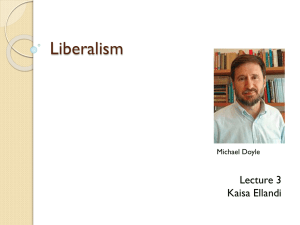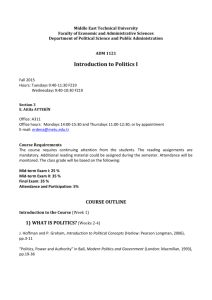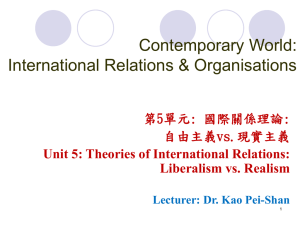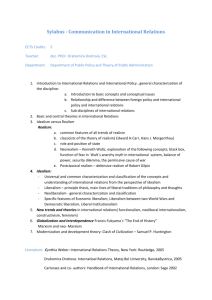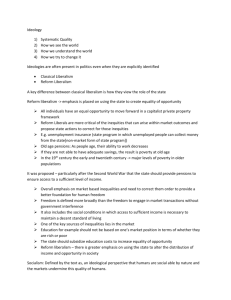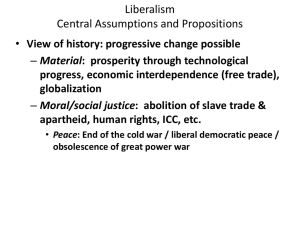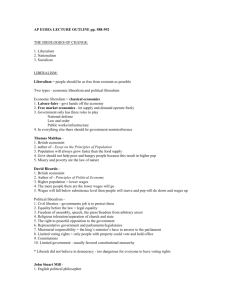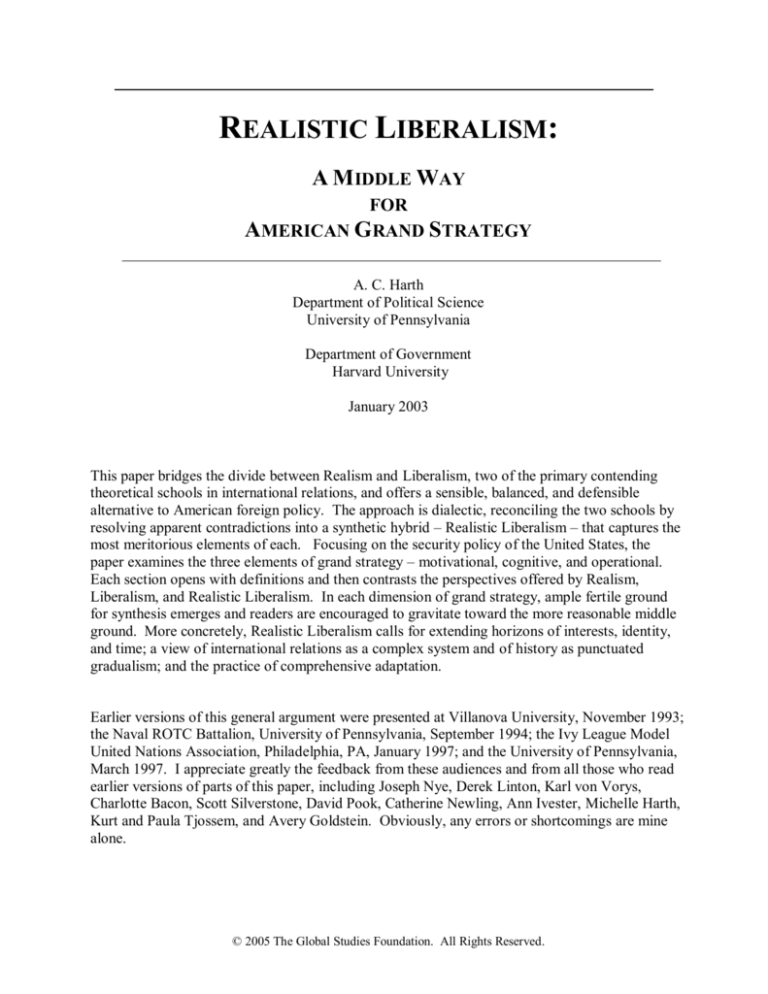
REALISTIC LIBERALISM:
A MIDDLE WAY
FOR
AMERICAN GRAND STRATEGY
A. C. Harth
Department of Political Science
University of Pennsylvania
Department of Government
Harvard University
January 2003
This paper bridges the divide between Realism and Liberalism, two of the primary contending
theoretical schools in international relations, and offers a sensible, balanced, and defensible
alternative to American foreign policy. The approach is dialectic, reconciling the two schools by
resolving apparent contradictions into a synthetic hybrid – Realistic Liberalism – that captures the
most meritorious elements of each. Focusing on the security policy of the United States, the
paper examines the three elements of grand strategy – motivational, cognitive, and operational.
Each section opens with definitions and then contrasts the perspectives offered by Realism,
Liberalism, and Realistic Liberalism. In each dimension of grand strategy, ample fertile ground
for synthesis emerges and readers are encouraged to gravitate toward the more reasonable middle
ground. More concretely, Realistic Liberalism calls for extending horizons of interests, identity,
and time; a view of international relations as a complex system and of history as punctuated
gradualism; and the practice of comprehensive adaptation.
Earlier versions of this general argument were presented at Villanova University, November 1993;
the Naval ROTC Battalion, University of Pennsylvania, September 1994; the Ivy League Model
United Nations Association, Philadelphia, PA, January 1997; and the University of Pennsylvania,
March 1997. I appreciate greatly the feedback from these audiences and from all those who read
earlier versions of parts of this paper, including Joseph Nye, Derek Linton, Karl von Vorys,
Charlotte Bacon, Scott Silverstone, David Pook, Catherine Newling, Ann Ivester, Michelle Harth,
Kurt and Paula Tjossem, and Avery Goldstein. Obviously, any errors or shortcomings are mine
alone.
© 2005 The Global Studies Foundation. All Rights Reserved.
1
Over the last year, in addition to fighting terrorism, defeating the Taliban, creating a
Department of Homeland Security, preparing to go to war with Iraq, and winning the midterm
elections, policymakers in the Bush administration have been busy trying to piece together a grand
strategy for the United States – partly to coordinate their own efforts and partly to comply with the
Goldwater-Nichols Act, which requires every administration to submit to Congress an annual
report on its national security strategy. Officially released in September, the Bush
administration’s report contains some new ideas and approaches, as well as a host of more
traditional formulations concerning the ends and means of American security policy. 1 Held over
from the past are the principles and rhetoric about supporting freedom, democracy, development,
free markets, free trade, human dignity, and even environmental protection, as well as about
engaging in multilateralism, strengthening alliances, battling terrorism, and shoring up our
position here at home. In these areas, the new Bush strategy, what one commentator refers to as a
“grand strategy of transformation,”2 looks much like its predecessors from the Reagan, Bush, and
Clinton administrations.
To be fair, there is a renewed emphasis on coalition building and increased attention on
terrorists, not just tyrants, as threats and on “great powers.”3 Even more profound, however, are
1
The National Security Strategy of the United States of America (Washington: The White House, September 2002).
This document pulls together various strands of thought and policy offered by the administration in several prominent
previous statements. Among the most important are the following: President Bush, Inaugural Address, January 20,
2001; President Bush, Address to a Joint Session of Congress and the American People, United States Capitol,
Washington, D.C., September 20, 2001; President Bush, Remarks on War Effort, The Citadel, Charleston, SC,
December 11, 2001; President Bush, State of the Union Address, United States Capitol, Washington, D.C., January
29, 2002; President Bush, Remarks at the 2002 Graduation Exercise of the United States Military Academy, West
Point, NY, June 1, 2002; and President Bush, Remarks to the United Nations General Assembly, New York,
September 12, 2002. The report was followed up in December with the release of a separate document detailing the
administration’s counter-proliferation strategy: National Strategy to Combat Weapons of Mass Destruction
(Washington: The White House, December 2002).
2
John Lewis Gaddis, “A Grand Strategy of Transformation,” Foreign Policy, No. 133 (November/December 2002).
3
Ibid. In a recent presentation at Harvard University’s Weatherhead Center (December 10, 2002), Gaddis also
identified as novel an interest in “making the world safe for democracy.” This objective, as he admitted, harkens back
to Woodrow Wilson and has been shared, at least ideally and rhetorically, by every administration since. While its
increased prominence might make it seem new, the Clinton administration espoused very similar objectives,
2
the changes concerning preemption, preponderance, and prevailing. Moving well beyond
containment, meeting threats, and intra-war deterrence, the Bush Doctrine clearly embraces
preventive war4 and seeks not just to avoid, deter, or end conflicts, but to “fight and win” – “to
defeat any attempt by an enemy – whether a state or non-state actor – to impose its will on the
United States, our allies, or our friends.”5 Leaving behind reactive policies and principles like nofirst use,6 the administration has adopted a proactive policy of striking first in the belief that “our
best defense is a good offense.” While preemption may be necessary when facing suicidal
adversaries armed with weapons of mass destruction, general reliance on an offensive posture and
seeking to prevail in all conflicts might not yield the security outcomes envisioned.
An even more troubling dimension of this new Bush Doctrine is the call for strength and
military forces “beyond challenge” – “enough to dissuade potential adversaries from pursuing a
military build-up in hopes of surpassing, or equaling, the power of the United States.” The basic
problem with such policies of preempting, prevailing, and preponderating is the crisis and strategic
instability they generate; they inadvertently tend to invite the outcomes they ostensibly seek to
avoid. While preemption might work against al Qaeda, for example, preventive war against Iraq
especially during the first term. See, for example, Anthony Lake, “From Containment to Enlargement,” Address at
Johns Hopkins School of Advanced International Studies (Washington, September 21, 1993), Reprinted in US
Department of State Dispatch, Vol. 4, No. 39.
4
The difference between preventive and preemptive war is significant and appears to have been lost in the Bush
administration’s lexicon. Preemption involves striking an adversary first when facing an imminent attack, and so is
justified as a means of self-defense and last-resort. Prevention, in contrast, involves the attacking an adversary’s
capacity to wage war not only prior to its use, but prior to its reaching a threatening level. What exactly is considered
threatening and justifiable in this latter instance often is unclear and typically varies by circumstance and beholder.
Beyond the slippery slope this represents for American policymakers, one must wonder about the example the United
States, as the most powerful actor in the international system, is setting for other states who face their own perceived
threats, especially those armed with or developing weapons of mass destruction.
5
President Bush used the former phrase in his Citadel speech, and has spoken numerous times about “fighting and
winning the war on terrorism.” The second passage comes from The National Security Strategy of the United States
of America. All the quotations below without references come from that document.
6
The recent counter-proliferation strategy even offers a not well veiled threat to use our own “conventional and
nuclear response and defense capabilities” to deal with threats to the United States or to our interests. This threat to
use “overwhelming force,” including “through preemptive measures,” might make sense in some scenarios, but raises
serious concerns about stability, the Just War principle of proportionality, and even the lessons about the underlying
balance of power which the participants and other actors might derive from the experience. Quotations from National
Strategy to Combat Weapons of Mass Destruction, p. 3.
3
might catalyze other states, like North Korea and Iran, to hasten their development of nuclear
weapons in the hope of deterring an American attack. Similarly, committing ourselves to fight
and win a war fought with weapons of mass destruction might preclude sensible exit options if
deterrence fails. Moreover, claims of greatness and power beyond reach might serve to rally other
actors, especially self-respecting great powers, against the United States.7 It is one thing to be on
top of the hill, another to try to remain there, and another altogether to tell everyone else that they
will never be able to knock us off.
In short, one can criticize much about the substance and style of the Bush administration’s
approach to foreign policy and national security. Nevertheless, we may quickly reach a point of
diminishing returns, or even counter-productivity, given the importance of the subject and our ongoing war. At a recent seminar on the Bush grand strategy, one of the participants challenged the
critics to “stop biting at the administration’s ankles” and to offer a viable alternative. With this
admonition in mind, I offer another option, a middle way for American grand strategy – what I
term “Realistic Liberalism.”
The Context and Need for Realistic Liberalism
Of course, I am not the first or only person to suggest the need for a new approach. Over
the last decade, and especially in the wake of 9/11, most analysts of American foreign relations
have recognized the need for change and many have called for new approaches. Debate continues
to rage about options.8 While wrestling with the same issues and allegedly striving for the same
7
While clear, determined, and coordinated efforts to counter-balance the United States may be hard to find,
particularly since 9/11, more obvious are the growing resentment, suspicion, and hostility expressed toward the United
States by people all over the world, including some of our closest allies and largest aid recipients. For more on this
growing anti-Americanism, see the results of the recent global survey conducted by the Pew Research Center, “What
the World Thinks in 2002,” available at http://people-press.org/reports/.
8
One of the best expositions of some of the alternatives – (1) isolationism (hiding); (2) selective engagement
(balancing); (3) cooperative security (binding); and (4) primacy (assimilating, hegemony, or empire) – remains Barry
4
end – a viable foreign policy – many of these arguments seem to speak past one another.
Contributing to such discursive difficulties and impeding resolution of important policy debates
are differing theories, the simplifying intellectual lenses that either explicitly or implicitly
undergird opinion. Consider, for example, recent controversies over topics like terrorism, the
“axis of evil,” ballistic missile defense, and appropriate relations with Russia and China.
Theoretical questions underlie such contentious policy issues: whether we should rely on military
or non-military means; whether we should seek change or containment; whether we should rely on
ourselves or others; and whether we should balance or bind. Answers to such questions and
resultant policy prescriptions are likely to differ and cause consternation if flowing from
antithetical theoretical frameworks.
Today much of the discordance about the direction of American foreign policy stems from
an underlying disconnect between the two predominant schools of thought in international
relations: Realism and Liberalism. 9 On one hand, Realists typically call for some form of
selective engagement, a conservative strategy based on narrowly defined national interests, a
cyclic and pessimistic outlook, and a preference for unilateral and bilateral means, particularly for
military force. Liberals, on the other hand, often juxtapose this traditional balancing formula with
collective security, a more progressive approach involving a broader definition of ends, a more
optimistic and evolutionary worldview, and a preference for multilateralism, institutions,
diplomacy, and other non-violent foreign policy tools. While useful for heuristics and as
analytical frames, both of these theoretical schools fail to provide the best guidelines for American
R. Posen and Andrew L. Ross, “Competing Visions for US Grand Strategy,” International Security, Vol. 21, No. 3
(Winter 1996/97).
9
A third major theoretical school, constructivism, is noteworthy for its significant intellectual insights, especially
concerning epistemological and ontological issues, and is a potentially useful complement these two schools. It does
not share, however, the same type of rich historical legacy in the American diplomatic tradition; nor, as a school of
thought, does it offer the same degree of direct applicability to pressing policy problems. For a comparison of these
three schools, see Stephen M. Walt, “International Relations: One World, Many Theories,” Foreign Policy, Spring
1998.
5
security policy; both contain elements of truth and identify necessary conditions, but neither alone
captures the totality of the challenge nor offers a sufficient approach.
To transcend this debate and provide a firmer theoretical foundation for American foreign
policy, this essay introduces a synthetic hybrid – Realistic Liberalism – that integrates the
meritorious and necessary elements of each viewpoint into a balanced, sensible, and defensible
alternative. The essence of this approach is to pursue largely liberal ends with realistic means. As
E. H. Carr has pointed out, one without the other poses problems: sound political thought and
action requires both elements. 10 While attempting to capitalize on opportunities and to improve
national and global conditions, for instance, policymakers must not lose sight of current reality.
Obstacles, constraints, and dangers must be recognized and constructively redressed, not ignored
or wished away. However, to focus exclusively on the immediate circumstances limits potential
development and denies possibilities for improvement. Instead, one must marry a forwardlooking vision with a grasp of current conditions, the normative with the practical, and the
desirable with the feasible. The yang of Realism and the yin of Liberalism are compatible and
complementary elements of a larger whole. Exclusive adoption of either will likely produce
imbalance and lead to motivational, cognitive, and operational difficulties. By integrating and
balancing these two approaches, Realistic Liberalism strives to effect a better tomorrow without
forsaking the needs of today.
This is not the first attempt to come to terms with these two schools of thought. In addition
to Carr, other analysts have recognized their conflicting impulses and the need to at least consider
both theories, if not to actually reconcile them. Fifteen years ago, for example, James Billington
10
Edward Hallet Carr, The Twenty Years’ Crisis, 1919-1939: An Introduction to the Study of International Relations
(New York: Harper and Row, 1964).
6
clearly stated “we need vision as well as realism in our foreign policy.” 11 This is particularly true
given both the idealistic, missionary impulse in American political culture and the concurrent need
to operate in the Westphalian international system, with its persistent premium on states and
power. Others have made similar suggestions. Criticizing both “classical realists” and “rigid
Wilsonians,” former National Security Advisor Anthony Lake, for instance, has called for a
“coalition of the center” and for the United States “to be principled about our purposes but
pragmatic about our means.”12 Likewise, Joseph Nye has sought to focus more attention on the
relationship between the two schools and on the need “to transcend the classical dialectic between
Realist and Liberal theories of international politics.”13
While laudable for their intent and for catalyzing efforts like this, these earlier attempts fall
short of bridging the gap between the two schools and of offering a clear, coherent, and practical
alternative. Hence, this essay synthesizes more completely these complementary perspectives and
articulates a theoretical framework that is directly applicable to the ends and means of American
security policy. Realistic Liberalism thus offers a cogent viewpoint that is both theoretically
informed, historically grounded, and relevant to policy. Far from trying to sit between two stools
or simply muddying the waters,14 this dialectic process of considering both Realism and
Liberalism and reconciling their apparent contradictions yields a hybrid approach that captures the
necessary and sufficient elements of an effective foreign policy for the United States.
11
James H. Billington, “Realism and Vision in American Foreign Policy,” Foreign Affairs, Vol. 65, No. 3 (America
and the World 1986).
12
Anthony Lake, “The Need for Engagement,” US Department of State Dispatch, Vol. 5, No. 49 (1994) and “From
Containment to Enlargement,” US Department of State Dispatch, Vol. 4, No. 39 (1993).
13
Joseph S. Nye, Jr., “Neorealism and Neoliberalism,” World Politics, Vol. 40, No. 2 (Jan. 1988).
14
Here, I break with Legro and Moravcsik, who use this latter analogy in arguing for maintaining intellectually
distinct paradigms and trying to develop a “set of well-constructed first-order theories.” While such an approach may
be advisable, even necessary, for causal analysis, the testing of theories, and the advancement of science, combining
the meritorious and applicable elements of different theories can help us better understand our world and craft
appropriate policies – both of which also seem advisable, even necessary. For the original statement, see Jeffrey W.
Legro and Andrew Moravcsik, “Is Anybody Still a Realist?” International Security, Vol. 24, No. 2 (Fall 1999), p. 50.
7
To better convey the essence of this approach, let us contrast it with the Realist and Liberal
alternatives in the context of a possible grand strategy for the United States. Broadly speaking, a
grand strategy is how a country secures itself and its future. It is based upon a shared belief
structure in the minds of policymakers about how to relate means to ends, how to achieve
objectives and promote interests, how to protect against dangers and minimize threats, and how to
confront problems and seize opportunities in the most advantageous and efficacious way. In their
purest form, grand strategies have three constituent elements: (1) motivational – an identification
and prioritization of interests and objectives, the ends to be pursued; (2) cognitive – an assessment
of the environment and an identification and prioritization of threats, obstacles, and problems, as
well as opportunities; and (3) operational – the selection and employment of the most appropriate
and efficient means to achieve the specified ends in the given environment. 15 The ideal grand
strategy integrates these three components into a coherent, multi-faceted policy that can best
provide security.
The American experience with grand strategies is mixed, in terms of both formation and
implementation. First, the United States, like other multi-party democracies, has often struggled
to articulate a single, unified grand strategy, to say nothing of actually executing one.
Nevertheless, in previous eras in its history, the United States attempted at least three different
security strategies: hiding, with the Monroe Doctrine’s emphasis on hemispheric isolation and
non-intervention in European affairs; balancing, with the Truman Doctrine’s focus on containment
of Soviet communism; and most recently, binding, with the Clinton Doctrine’s aim of enlargement
of the community of capitalist democracies. Second, these doctrines and others practiced by the
United States were rarely one-dimensional; instead, they typically integrated parts of different
15
This definition of grand strategy is drawn largely from Barry Posen, The Sources of Military Doctrine: France,
Britain, and Germany Between the World Wars (Ithaca: Cornell University Press, 1984).
8
strategies to complement the primary set of ends and means. Thus, the containment of Soviet
communism espoused by NSC-68, for example, was effectively combined with the integration of
Western Europe through the Marshall Plan and NATO. A similar composition characterizes the
other three major strategies, especially the Clinton Doctrine, with its amalgamation of hiding,
balancing, binding, and dominating. In fact, most lasting American foreign policy successes
appear to result from a joining of Realist and Liberal approaches and to involve some combination
of sticks and carrots.
Realistic Liberalism seeks to build on this record and purposefully synthesizes Realism
and Liberalism to capitalize on their respective strengths and to compensate for their potential
shortcomings. More concretely, Realistic Liberalism calls for a grand strategy based on extending
horizons, a view of international relations as a complex system and of history as punctuated
gradualism, and the practice of comprehensive adaptation. To explain this approach and to
highlight its features, let us disassemble the notion of grand strategy and examine its three
constituent elements from the perspectives of the three contending schools. For the sake of
manageability, let us focus presently on theoretical questions and insights, not on the policy
debates they fuel, the particular positions people advocate, or the many supporting examples
available.
Motivation – An Identification and Prioritization of Interests
The most important and perhaps most difficult step in addressing national security
concerns is the first – namely, the identification and prioritization of interests, or ends to be
pursued. Without specified interests, how can one identify and prioritize the threats to them?
Likewise, without first identifying ends, how is one to select the most appropriate means? As
ambiguous a concept as “national interest” may be, there are certainly objectives that can and must
9
be identified, prioritized, and actively pursued – and these serve as the foundation and starting
point of any grand strategy.
Realists tend to emphasize the physical security of the territorial United States and
occasionally its closest allies. Drawn largely from experience in previous eras and a sense of
national identity, their definition of security usually rests on two pillars – (1) territorial integrity
and (2) political independence – and is often buttressed by the need to protect values, institutions,
and people. Concerns about stability and power, primarily military power, drive policy. Focused
on the near-term, Realists seek to protect and promote America’s position and status.
Accordingly, America must maintain its relative power or, better yet, amass as much power as
possible, and prevent other actors from increasing their power or exerting their will over the
United States.
Liberals have a broader view of America’s interests, encompassing additional dimensions
and often a larger geographic scope. Not only is the focus on one country deemed insufficient, but
even states themselves are seen as limiting constructs. Casting a wider net, many Liberals speak
in terms of international or global interests, espousing notions like “human security.” Often
included are such grand objectives as peace, prosperity, and improving human welfare. The
emphasis is on creating a better future, on reducing conflict, poverty, malnutrition, disease, and
insecurity. According to this perspective, the inherent dynamism and interconnectedness of the
planet feeds back into the definition of interests – it makes little sense to think only in binary,
zero-sum terms if we all are in this together over the long haul. Instead, Liberals suggest stepping
outside of traditional boxes and thinking anew about interests and identity.
Realistic Liberalism recognizes the useful elements in both of these positions and strives to
reconcile their apparent contradictions. On one hand, it adopts the progressive orientation of
10
Liberalism and strives to move beyond the status quo. On the other hand, it grasps fully both the
utility and the limits of power – military, economic, political, and socio-cultural – in effecting
change in international relations. Thus, Realistic Liberalism simultaneously accepts Realist
arguments, on one hand, like Thucydides’ claim that the strong do what they will and the weak
suffer what they must and Nicholas Spykman’s proposition that those who renounce the struggle
for power will cease at some point to influence international relations either for better or worse, 16
and Liberal arguments, on the other, such as violence tends to beget violence and hatred rarely
ceases with more hatred.
To integrate these two perspectives, a multidimensional vision is necessary, one involving
extending horizons. More specifically, Realistic Liberalism advocates extending America’s
horizons in three areas: (1) expanding the definition of national security beyond traditional
elements; (2) broadening America’s viewpoint and sense of identity, to start thinking of others, not
just nationals; and (3) lengthening decision-makers’ time frames, to consider long-term interests as
well short-term needs. Let us consider each of these individually, recognizing their
interconnectedness and dynamism and the concomitant emergent conditions.
For the first and minimal step in extending horizons, the United States should build on the
Realist definition of security and strive for an expanded set of criteria encompassing five essential
elements: (i) territorial integrity, including the protection of property, institutions, and people; (ii)
political independence, particularly the ability to make decisions about one’s own future; (iii)
economic vitality, ideally combining a reasonably stable and secure environment with some
growth, particularly in productivity; (iv) environmental sustainability, especially so that one can
enjoy “territorial integrity” over the long-haul; and (v) social cohesion, so that the nation can
16
Thucydides, The Peloponnesian War (New York: Modern Library, 1951) and Nicholas J. Spykman, America's
Strategy in World Politics: The United States and the Balance of Power (New York: Harcourt, Brace, and Co., 1942).
11
survive and thrive as a community of individuals along the lines the founding fathers envisaged –
namely, E Pluribus Unum. The choice is not between Realist calls for “more guns” and Liberal
calls for “more butter.” As Jacob Viner suggested half a century ago, power and plenty are not
just compatible, but mutually reinforcing objectives. 17 History has demonstrated repeatedly that
one cannot be sustained without the other, especially over the long-term. 18 So, too, are territorial
integrity and environmental sustainability compatible and reinforcing – the key distinction is time
horizon. Even social cohesion jibes with the others: it is necessary both for political independence
to be meaningful and for economic vitality to be possible. Ultimately, all five factors work
together and reinforce each other to provide a sound base for lasting security.
While pursuing this more complete conceptualization of national security, American
policymakers also must recognize the prevailing trends underway, particularly the globalizing
forces of technology – for communication, transportation, and destruction – that are eroding the
integrity and independence of all states, and start to broaden America’s sense of identity for the
future. As borders become more porous to the flow of ideas, information, goods, and weapons,
states lose their ability to control events. New communities of interests are emerging to meet the
needs of their constituents. States may lose their hitherto unrivaled position as security providers
and find themselves challenged from above with international and supranational institutions and
from below by individuals, transnational groups, non-governmental organizations, and other substate actors. The United States needs to grasp the significance of these current trends, to recognize
its growing connectedness to “others,” and to think and act accordingly. Failure to do so will not
17
Jacob Viner, “Power and Plenty as Objectives of Foreign Policy in the Seventeenth and Eighteenth Centuries,”
World Politics, Vol. 1, No. 1 (Oct. 1948).
18
See Paul Kennedy, The Rise and Fall of Great Powers: Economic Change and Military Conflict from 1500 to 2000
(New York: Random House, 1987).
12
change reality or stop the trends. Globalization will continue with or without Americans
recognizing its effects.
Finally, decision-makers also must extend their time horizons. While vital and necessary,
short-term considerations alone are insufficient. A view to the future should balance a complete
and honest accounting of current needs. To survive, to say nothing of progress, policymakers
must plan and provide for both expected and unexpected future developments. Investments are
essential for future dividends; so is flexibility for dealing with unforeseen events. Setting
progressive, long-term objectives can improve our limited ability to shape the future – to create the
future we want to live in, we must set goals. If America fails to identify where it wants to go, it
will be unlikely to get there. Realistic Liberalism thus calls for a combination of near-term pursuit
of a broadened definition of national security with an ongoing effort over the longer term to
reorient our policies away from states and military power toward people and politics, economics,
and the environment. While challenging, such an approach of extending horizons is necessary
both to secure the present and to improve the future – two compatible and complementary
objectives.
Cognition – An Assessment of the Post-Cold War Environment
Extending horizons are particularly necessary considering the subject of the second-tier of
grand strategy – the environment – that not only serves as the milieu for conducting foreign
policy, but also influences the selection of both ends and means. After extending their views of
interests, identity, and time, American policymakers should then assess the factors that could
impede or facilitate the actualization of their specified objectives. In what type of a world must
America pursue its security? What factors matter most? How do they influence international
13
relations? What are the historical trends? More specifically, what are the threats and
opportunities facing the United States today and what are they likely to be in the future? Answers
to questions like these have profound policy implications as cognition largely shapes and guides
operational decisions and forms the intellectual framework for any grand strategy.
Most Realists have a bleak view of the operating environment. Life, as Hobbes noted, is
nasty, brutish, and short. Their underlying assumption is that human nature is base, selfinterested, and, for the most part, immutable. Focusing primarily on structural features, like
anarchy and the distribution of capabilities, they see little change in international relations over
time. Anarchy persists, and threats loom larger than opportunities. History, from this perspective,
offers some lessons, but is largely cyclical – with little hope of escape or progress. Stuck in
similar structural circumstances, humans are likely to exhibit similar behavior – in an anarchic
environment, for instance, they will struggle to survive, which usually results in a balance of
power.19 In the current context, many Realists emphasize not only anarchy and the competition
for relative power among states but the strengthening of centrifugal forces in the international
system. The collapse of bipolarity after the Cold War took with it much of the associated stability
and predictability. From this perspective, disorder and chaos are growing, dangers are increasing,
and the world is falling apart. Moreover, most Realists argue, little can be done to rectify this state
of affairs – at best, one can narrowly define interests, recognize dangers and threats, and prepare
assiduously to fight and win the battles ahead.
Liberals offer a fundamentally different and much rosier picture of the operating
environment. First, they focus on agents, like states, people, and interest groups, and not on
structure. Second, their view is inherently optimistic and holds out the potential for learning and
positive change. While states per se cannot learn, people can and do. People are ultimately the
19
Kenneth N. Waltz, Theory of International Politics (New York: McGraw Hill, 1979).
14
ones deciding and acting, so there is room for hope. Thus, historical trends are mutable – agents
can and do make a difference, often mollifying the salience of structural influences, if not
modifying the structure itself. Because of this emphasis on agency and learning, Liberals are more
positive about the present and the future. People are not doomed to repeat cycles of history;
instead, history is progressive. In the current context, centripetal forces are seen as outweighing
centrifugal forces – the world is unifying, not fragmenting. Organizations, institutions, and other
regimes are pulling people together, as are new technologies and transnational ideas. Instead of an
intensifying struggle for survival in anarchy, Liberals see thickening webs of interaction and
interdependence generating a new global community.
Realistic Liberalism recognizes the merits of these contending perspectives and suggests
that a more complete and useful picture of international relations and history is obtainable through
synthesis rather than by exclusive adoption of either framework. That structures matter, for
example, is hardly worth contesting. The same is true for agency. Decisions and policies are
made by people operating in specific environments characterized by particular structures and
norms. Or, to paraphrase Karl Marx and Friedrich Engels, people make history, but not always in
the circumstances of their choosing. 20 To argue that one matters and the other does not convolutes
history and misses the interactive essence of systemic behavior. Thus, rather than arguing for one
or the other, Realistic Liberalism integrates agency and structure and models international
relations as a complex adaptive system (CAS). 21 Inherently dynamic, interactive, and
20
Karl Marx and Frederick Engels, The German Ideology [1846], in Robert C. Tucker, ed., The Marx-Engels Reader,
Second Edition (New York: W.W. Norton, 1978).
21
For a readable definition of such systems and their features, see John Holland, Hidden Order: How Adaptation
Builds Complexity (Reading, MA: Addison-Wesley, 1995). See also Murray Gell-Mann, The Quark and the Jaguar:
Adventures in the Simple and the Complex (New York: W. H. Freeman, 1994) and John L. Casti, Complexification:
Explaining a Paradoxical World Through the Science of Surprise (New York: Harper Collins, 1994). This
relationship between agency and structure is similar to the “duality” suggested by “structuration theory” – see
Anthony Giddens, General Problems in Social Theory (Berkeley: University of California, 1979) and The
Constitution of Society (Cambridge: Polity, 1984).
15
unpredictable, such systems are capable of evolution, of progress based on learning and feedback
loops. While certain patterns of behavior are evident (in the form of attractors), minor
perturbations of the system can manifest dramatic changes over time. Given a large number of
interactive variables, small changes in initial conditions can magnify over iterations to produce
unrecognizable and unpredictable outcomes. In other words, the same “butterfly effect” found in
weather patterns characterizes most other complex systems as well – including international
relations. 22 Behaviors as divergent as wars and revolutions, on one hand, to stock market
fluctuations and socio-cultural movements, on the other, seem to exhibit the same type of
nonlinear patterns.
So, while history is not as linear as Liberals suggest, it is neither as cyclical as Realists
argue. Instead, it exhibits evolutionary tendencies that are best described as “punctuated
gradualism.”23 The vast majority of changes take place in small, incremental steps over time
causing the appearance of long periods of relative stasis. These periods are punctuated, or
interrupted occasionally, not regularly, by events, sometimes large and sometimes small, which
cause changes in the system. The changes themselves can be large or small, progressive or
regressive. The system then settles down again at a new “equilibrium,” one of many potential and
not necessarily optimal intermediary stages where the interactive dynamic continues, until another
critical point is reached and more profound changes occur. Point predictions of when or how such
changes will take place are impossible. No certainties govern complex adaptive systems. Never
22
For a discussion of the “butterfly effect” and its discovery, see Edward N. Lorenz, The Essence of Chaos (Seattle:
University of Washington Press, 1993).
23
A derivative of the more popular “punctuated equilibrium” coined in 1972 by biologists Niles Eldredge and Stephan
Jay Gould to explain speciation, this term better captures the ongoing process of change that is often lost in larger time
frames. Consider, for example, that the Cretaceous extinction, usually identified as a “punctuation” in geologic time,
took more than 5 million years. The term itself is borrowed from Bjorn A. Malmgren, W. A. Berggren, G. P.
Lohmann, “Species Formation through Punctuated Gradualism in Planktonic Foraminifera,” Science, Vol. 225 (July
20, 1984). For the original statement, see Eldredge and Gould, “Punctuated Equilibria: An Alternative to Phyletic
Gradualism,” in T. J. M. Schopf, ed., Models in Paleobiology (San Francisco: Freeman, 1972).
16
reaching a final endpoint, they are in a continual process of becoming – they are emergent.
Change is continual, but the rate of change varies. Nevertheless, the duration, magnitude, and
frequency of most changes in such systems follow the power law, with its logarithmic relationship
between length or size and frequency. 24 By recognizing such patterns in international relations, as
well as the vital connection between agency and structure, Realistic Liberalism offers a hybrid
conceptualization of history that is more valid and applicable than those provided by either
Realism or Liberalism alone.
A similar synthesis is possible and desirable when analyzing the specific features of the
post-Cold War world. The question is not whether the world is coming together or falling apart,
integrating or fragmenting, or whether centripetal or centrifugal forces are at work. The reality is
that both are occurring simultaneously, though not necessarily evenly. To use Stephen J. Gould’s
terminology, some parts of the world are caught in “time’s cycle” and others are riding “time’s
arrow.”25 Some parts, like Africa and the Middle East, exhibit less order and more conflict,
others, like Western Europe and North America, more order and integration. In other words, some
regions are characterized more by potential threats to American interests, some more by
opportunities to advance them. Most areas exhibit a combination of these two sides. In East Asia,
for example, both centripetal and centrifugal forces are clearly at work with the distribution of
power, geography, culture, and institutions like ASEAN and APEC pushing in one direction and
nationalism, militarism, and mercantilism pulling in the other. Thus, rather than taking a blanket
24
For two powerful and sweeping applications of this emergent paradigm, including elaborate discussions of this
ubiquitous power law, see Per Bak, How Nature Works: The Science of Self-Organized Criticality (New York:
Copernicus, 1996) and Mark Buchanan, Ubiquity: The Science of History … or Why the World is Simpler than We
Think (London: Weidenfeld and Nicolson, 2000).
25
Stephen Jay Gould, Time's Arrow, Time's Cycle: Myth and Metaphor in the Discovery of Geological Time
(Cambridge: Harvard University Press, 1987). For two useful applications of this type of framework to international
relations, see John Lewis Gaddis, “International Relations Theory and the End of the Cold War,” International
Security, Vol. 17, No. 3 (Winter 1992/93) and Robert Jervis, “The Future of World Politics: Will it Resemble the
Past?” International Security, Vol. 16, No. 3 (Winter 1991/92). For a more popular account of the conflicting
tendencies of the post-Cold War period, see Benjamin Barber, Jihad vs. McWorld (New York: Times Books, 1995).
17
approach and casting the debate in “either/or” terms, a more nuanced approach is required, one
that recognizes the compatibility and coexistence of these two apparently opposing forces.
Consequently, Realistic Liberalism suggests guarded optimism about the future, recognizing that
change and progress are always possible, though never easy. While such synthesis can complicate
analysis and exercises like theory testing, it provides for a more accurate and complete picture of
the environment. Additional good news comes from the fact that in nature most systems organize
themselves toward this critical state – what Stuart Kauffman calls “the edge of chaos” – and most
creativity and growth take place where both order and chaos are present. 26 To maximize and
channel this creativity toward constructive ends, however, one must possess and use the proper
foreign policy tools.
Operation – A Selection of Appropriate Foreign Policy Tools
The final step in formulating a grand strategy involves selecting the most appropriate
means available to accomplish the stated objectives in the given environment. What policies and
practices can best protect and promote American interests in the present and future? What foreign
policy tools should the United States employ to maximize opportunities and to minimize dangers?
How much should it rely on military might, for example, as opposed to diplomacy or economic
tools? How much should it practice unilateralism or rely on bilateral arrangements as opposed to
regional arrangements or multilateral institutions? Given the contrasts between the contending
schools in the motivational and cognitive spheres, it is hardly surprising that similar discordance
arises in the operational dimension. Nevertheless, an examination of the Realist and Liberal
approaches reveals plenty of fertile ground for dialectic synthesis.
26
Stuart A. Kauffman, Origins of Order: Self-Organization and Selection in Evolution (New York: Oxford University
Press, 1993).
18
Working from their suppositions concerning interests and the environment, most Realists
tend to favor traditional foreign policy tools. Military force, in particular, has always had a special
place in Realist foreign policies – for when the cards are on the table, force trumps all. The
preferred policy option for most Realists is balancing power, through either internal or external
means. Internally, one can increase strength through such activities as building arms, reorganizing
defense and intelligence arrangements, and developing technologies. Externally, one can increase
strength by constructing alliances, or “bandwagoning,” with other states. While holding out the
possibility of working with others to stave off military defeat, most Realists prefer to go it alone.
The hierarchy is clear and straightforward: unilateralism is better than bilateralism, which is better
than multilateralism. So, too, is the preference ordering among available tools: military might is
the means of choice. Realists tend to regard political or diplomatic arrangements, like
international institutions and arms control regimes as more reflective of the underlying distribution
of power than determinative and as usually doing more harm than good. Instead of placing their
faith in arrangements with questionable historical records or relying on others, most Realists
prefer to pursue security the old fashioned way – primarily by themselves and with a shield,
loaded gun, or both.
Liberals, in contrast, find such reliance on military means less than ideal, especially for
fostering positive, symbiotic relationships with others over the long term. Instead, diplomacy is
the preferred tool and multilateralism the most desirable form. Many Liberals seek to cement
relationships with institutions, to tie states together with political and economic agreements. They
hold in particularly high esteem concerts, security regimes, and organizations for their potential to
constrain would-be adversaries and to coordinate expectations. Thus, rather than balancing power
and threats, Liberals prefer to “bind” instead – to bring others closer, to tie futures together, and to
19
restrict by agreement destructive capabilities and hostile propensities. From this perspective,
some short-term risks are necessary for larger long-term gains. The driving assumptions are that
others are trustworthy and that over time they will reciprocate American good will and
forbearance.
Here, again, there is much room for synthesis and integration. Like the motivational and
cognitive dimensions, the operational tier should not be conceived in “either/or” terms. In other
words, it is not a choice of military versus economic or political means. Nor is it a question of
unilateralism versus bilateralism or multilateralism. Nor even is it a matter of balancing versus
binding. Rather than limit themselves unnecessarily, American policymakers should place all
options into a foreign policy toolbox and use them when needed and appropriate. That is, the
United States should practice comprehensive adaptation. This operational doctrine should be
comprehensive in three respects: (1) it should be based on a firm grasp and understanding of the
emergent landscape, with all of its dangers and opportunities, and of how to respond suitably to
the myriad challenges likely to arise; (2) it should be comprised of as many different foreign
policy tools and strategies as necessary and offer decision-makers a complete array of choices; and
(3) it should seek to include as many other actors, state and non-state, as possible. All options
should be available and considered, but only the most appropriate means employed. The keys to
successful adaptation are tailoring policies to fit particular problems and then adjusting them over
time as circumstances change or new challenges emerge. Predispositions should be avoided,
flexibility retained, and means selected and modified to produce the most favorable outcomes. In
short, operational decisions should be guided by pragmatism, not dogmatism. As with other
complex adaptive systems, feedback loops and related processes can help improve (or worsen)
20
results – in this case, ideally, providing security and promoting progress as decision-makers learn
from their experiences and adapt their policies, strategies, and tools accordingly.
For such a policy to work, the United States must possess both a multitude of
complementary foreign policy tools and the willingness to combine them in various ways. While
the United States currently possesses a wide range of tools and practices several different
strategies, it lacks balance between the different means available and between short- and long-term
time horizons. Consider, for example, the disproportionate spending on military means as
opposed to diplomacy and foreign aid. 27 While military tools are invaluable and can make
diplomacy more effective, history suggests that only for a limited time can one rely primarily on
military means and amassing power to stymie potential challengers before such efforts
boomerang, generating the same type of behavior in others. If America focuses all of its efforts on
staying on top of the hill in the near term, then over time others are likely to rally against it and
strive to knock it off. 28 One key to mitigating such tendencies, as witnessed by the failure of the
arrangements after World War I and the success after World War II, is to engage and integrate
other states, particularly great powers with potentially revisionist ideologies or leanings. The
exclusion of Germany and Japan, as well as Russia, after World War I, played no small role in the
failure of the League of Nations. In contrast, the inclusion of Germany and Japan after World War
II and their integration into the institutional framework of the “West” and subsequent
27
The United States spends nearly $400 billion annually on defense, but less than $25 billion on its international
affairs budget, including the conduct of foreign affairs, foreign security and economic assistance, foreign information
services, and developmental aid. As a percentage of GNP, the foreign aid contributions of the United States are only
one-tenth of one percent, ranking it last of the 22 developed countries in the OECD. The budgetary figures are drawn
from the “Historical Tables” of The Budget of the United States, Fiscal Year 2002, available at
http://www.whitehouse.gov/omb/budget/fy2002/hist.pdf. The foreign aid data come from the OECD and are available
at http://www.oecd.org/jpg/M00002000/M00002882.jpg.
28
For a more detailed argument along these lines, see Christopher Layne, “The Unipolar Illusion: Why New Great
Powers Will Rise,” International Security, Vol. 17, No. 4 (Spring 1993).
21
developmental success has helped make revanchism in these states all but unthinkable. 29
Undoubtedly, another key causal factor of the different outcomes of these two postwar settlements
was the role played by the United States: notably, its withdrawal and shirking of responsibilities
after the First World War; and, in stark contrast, its engagement and leadership after the Second
World War.
Such historical lessons should not be lost as America struggles after the Cold War to form
an appropriate foreign policy, especially vis-à-vis other great powers, like China, Russia, and
India. Each of these states, and other actors, represents a different set of conditions and
challenges: some are rising, some falling; some are politically compatible, some corrupt and
unstable, and some a mixture; some pose military threats, some economic opportunities, some
both, and some neither. While policies should be tailored as much as possible for different actors
and issues, Realistic Liberalism is widely applicable, particularly as operationalized in
comprehensive adaptation. Several general policy recommendations flow from this line of
thinking. First, when dealing with other states, particularly great powers, the United States should
engage and bind as much as possible, but balance as much as necessary. Likewise, the United
States should involve others and practice multilateralism wherever possible, relying on
unilateralism and bilateralism only where necessary. Military force should continue to play a role,
but, in accordance with the Just War Tradition, should be used only as a last resort and should be
applied discriminately and proportionally. Non-violent means should be employed whenever
possible – both to reduce human costs and to inculcate more civil norms – and military means
29
Cf. G. John Ikenberry, After Victory: Institutions, Strategic Restraint, and the Rebuilding of Order after Major
Wars (Princeton University Press, 2000); “America’s Liberal Hegemony,” Current History, January 1999; and his
contributions to his recently edited volume, America Unrivaled: The Future of the Balance of Power (Cornell
University Press, 2002).
22
when necessary. In short, America should do what it must in the near-term and what it can for the
long-term.
Conclusions
Thus defined, Realistic Liberalism is not a panacea, but a principled and pragmatic
approach to security. Applied to the three dimensions of grand strategy – motivational, cognitive,
and operational – it involves extending horizons of interests, identity, and time; viewing
international relations as a complex system and history as punctuated gradualism; and practicing
comprehensive adaptation to emergent conditions. Based on the belief that we can and should
strive to improve our circumstances and relations, it is progressive and optimistic. Given the
inherent dynamism and evolutionary tendencies of the global system, accepting the status quo will
never suffice – to say nothing of trying to freeze current conditions or, worse yet, trying to return
to a previous age. Rather than resist the flow of history, we should learn from it and try to shape
it. We must try to move forward, to improve our situation as a country, species, and planet.
Nevertheless, meaningful and lasting progress requires more than a liberal vision. It also
requires a clear-eyed view of the world as it is rather than as we would like it to be. It requires a
calculated assessment and integration of ends and means, of objectives and tools to accomplish
them. Also necessary are intensive and sustained efforts to effect the type of positive changes we
seek. Change is never easy, especially when it involves powerful and entrenched conceptions,
interests, and positions. To move forward and make long-term collective gains, we must be
willing to exert energy and make some short-term individual sacrifices – if the wealthiest and most
powerful country on the planet does not, what can be expected of others? The United States also
must recognize its own limits and select a path that enables the most progress, however gradual or
23
limited it might appear in the near term. When caught in a dangerous current, one should swim
neither directly with it nor directly against it. Instead, the wisest course is to swim diagonally
against the current, seeking to make incremental progress and taking advantage of all opportunities
to make headway, toward the ultimate objective of reaching safety.
Today, the United States has an extraordinary opportunity to refashion its foreign policy,
both because of the end of the Cold War and, more recently, because of the terrorist attacks that
have, at least temporarily, brought states together to fight a common (if elusive) enemy. We must
not let such an opportunity pass, especially while bogged down in fruitless debates about allegedly
incompatible theoretical approaches that actually make the most sense and offer the soundest
course of action when married together. As Abraham Lincoln put it: “The dogmas of the quiet
past are inadequate to the stormy present. The occasion is piled high with difficulty, and we must
rise to the occasion. As our case is new, so must we think anew and act anew. We must
disenthrall ourselves and then we shall save our country.” 30 The time has come to move beyond
the apparent dichotomy of Realism and Liberalism, beyond tendencies toward sterile conservatism
and naïve dreaming, to a new approach – Realistic Liberalism – that captures the necessary and
sufficient elements of a viable and effective approach to security. To do any less is to sell
ourselves and our future short.
30
Abraham Lincoln, Second Annual Message to Congress, Dec. 1, 1862, available at
http://www.theamericanpresidency.net/1862.htm.

